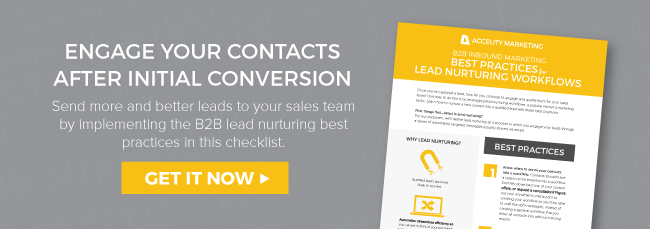Why Your B2B SaaS Company Needs Marketing Automation Software
.png?width=750&name=ACC_Blog_June19-02%20(1).png)
While there is truth in the phrase “your database is your most valuable asset”, your database will only ever be as powerful as you make it. Chances are you’ve spent significant time, marketing resources and money to build up your database; but if you’re not managing it properly, you’re throwing all that away.
Even when it comes to qualified leads, a study from Gleanster found that over 50% of leads aren’t ready to buy the same day they convert on your site. So how do you get these qualified leads to be sales-ready? By automating your lead nurturing process.
Deciphering the jargon
“What is a lead nurturing process?” you might be wondering. A lead nurturing strategy is a way of following up with an early-stage lead to provide value and retain their interest throughout the buyer’s journey. One of the most common ways to nurture leads is by sending a series of emails to keep them engaged and allow them to learn more about your company, services or industry. This strategy takes time and often a dedicated lead management team member. As a startup, these two things might be hard to come by; that’s why marketing automation software is a must.
Marketing automation software is an advanced platform designed to help marketers capture leads, nurture them further down the funnel, and analyze lead behavior and campaign performance. At Accelity, we use HubSpot—HubSpot’s free CRM is a combination of their sales software, marketing software and support software.
One of the many features that make this software great is the workflow tool. A workflow is a series of automated tasks that you can trigger to occur based on a specific action, date, a contact’s activity or stored contact information. With workflows, you can automate many processes like sending emails, updating contact information, removing or adding contacts to lists, creating tasks and quite a few other possibilities that will save you time and money.
A report by Market2Lead discovered leads that go through automated workflows have a 23% shorter sales cycle. Additionally, a survey conducted by Lenskold Group and The Pedowitz Group found that 60% of survey respondents that use marketing automation say it has increased the quality of the leads that get passed to sales.
So, what’s the catch? Well, there isn’t one. Workflows allow you to make the rules, send the right message to the right people and convert more leads to customers. Say hello to smarter marketing!
Utilizing workflows to nurture leads
Workflows give you the ability to make your rules; this includes setting enrollment criteria (what type of contacts will enter this workflow), the actions you want to trigger and the timing of each step. This customization is helpful because it allows you to segment and nurture your leads more effectively by sending the right message to the right person at the right time.
Speaking of timing, one neat feature within the workflow tool is the ability to customize timing; you are able to decide when each email or action should be triggered. This can be helpful if you have a few leads that are much closer to being ready to buy, you can have the workflow send them more emails per week than leads that are not as close to purchasing. Additionally, you can pick specific days of the week or times of the day you want emails to send, this is handy if you know your leads respond better in the evening or on the weekends.
One example of a lead nurturing workflow would be a series of actions that happens after a lead downloads a content offer on your website. Downloading the offer could be your enrollment criteria that triggers a follow-up email. You can have this email delayed to give the lead a chance to read the offer and find its value. You don’t want to send an email right after they download asking “How did you like this offer?”. You can add on this flow of actions by creating an if/then branch based on their response to the follow-up email—if the email was unopened then do Action X, if the email was opened then do Action Y.
A couple of other instances in which a workflow could help would be sending a series of emails to:
- Leads who have viewed a certain page on your website
- Leads with a specific website history like page views, clicks, etc.
- Leads from companies with more than a specific number of employees
- Leads from companies in a specific industry or location
- Leads from a specific source like social media
The best part about automating these emails? Lead nurturing emails get 4-10 times the response rate compared to standalone email blasts.
The days of sending one big email to all of your leads and hoping it’s relevant enough for some of them to click through or engage with it are done. It’s time to start using smarter tools to send your leads what they’re looking for and make them sales-ready faster.
Searching for more help to nurture and score your leads? Download our Lead Nurturing Best Practices checklist to learn how to create a process that allows you to streamline and create efficiencies so you can start sending more leads to your sales team!


